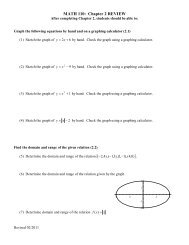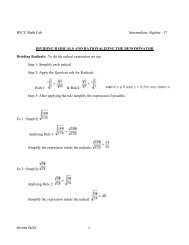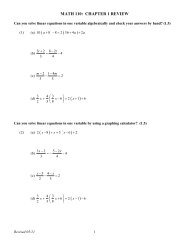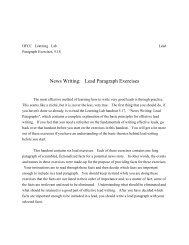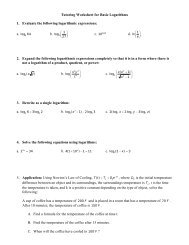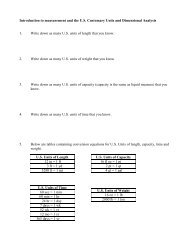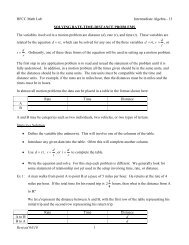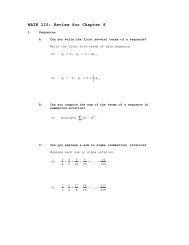Factoring ax^2+bx+c, a is not 1 - The Learning Lab at HFCC
Factoring ax^2+bx+c, a is not 1 - The Learning Lab at HFCC
Factoring ax^2+bx+c, a is not 1 - The Learning Lab at HFCC
You also want an ePaper? Increase the reach of your titles
YUMPU automatically turns print PDFs into web optimized ePapers that Google loves.
<strong>HFCC</strong> M<strong>at</strong>h <strong>Lab</strong> Beginning Algebra -19FACTORING TRINOMIALS2ax + bx + c ( a ≠ 1)In th<strong>is</strong> handout we will d<strong>is</strong>cuss one method of factoring a general trinomial, th<strong>at</strong> <strong>is</strong> an2expression of the form ax + bx + c where a, b, and c are constant, and usually integers.In particular, we will be concerned with the case where the leading coefficient <strong>is</strong> <strong>not</strong> one( a ≠ 1). When the leading coefficient <strong>is</strong> one ( a = 1), a shorter two-step method can beused to factor the trinomial.REMEMBER th<strong>at</strong> in every case you should FIRST check for a COMMONFACTOR before proceeding with any other method of factoring.<strong>The</strong> procedure to factor a trinomial of the form2ax + bx + c ( a ≠ 1) <strong>is</strong> as follows:1) Find the product of a and c,ac .2) Find two integers m and n such th<strong>at</strong> the product of m and n <strong>is</strong> ( ac ) and the sumof m and n <strong>is</strong> the coefficient of the middle term ( b ). Th<strong>at</strong> <strong>is</strong>:the product: ac = m • n and the sum: b = m + n .3) Rewrite the trinomial, using the numbers you found in step 2 to break the middle22term, th<strong>at</strong> <strong>is</strong>, rewrite ax + bx + c as ax + mx + nx + c .Note th<strong>at</strong> since b = m + n , so also bx = mx + nx , and therefore the rewritten22expression ax + mx + nx + c <strong>is</strong> equivalent to the original trinomial ax + bx + c .4) Factor out the Gre<strong>at</strong>est Common Factor (GCF) from the first two terms2ax + mx , and the GCF or –GCF from the second two terms nx + c5) Factor out the resulting common binomial factor.<strong>The</strong> above steps will become clearer as you follow through some examples.21) Factor 12x−13x− 4 completely:FIRST: check for COMMON FACTOR among the coefficients or the variables.In th<strong>is</strong> case the COMMON FACTOR <strong>is</strong> 1. <strong>Factoring</strong> 1 out will <strong>not</strong>simplify the problem.NOTE: a = + 12, b = − 13, and c = − 4Step 1: Find the product: ac = ( + 12)( − 4)= − 48Rev<strong>is</strong>ed 03/09 1
Step 2: Find m, n where m • n = − 48 and m + n = − 13 , herem = + 3 and n = − 16Step 3: Rewrite the trinomial using the two integers from step 2 to break up themiddle term.212x−13x− 4=212x 3x 16x4Step 4: = 3x( 4x + 1)4( 4x1)Step 5: =( 4x1)( 3x4)+ − − Split the middle term− + Factor the GCF from the first two terms andFactor the GCF from the second two terms+ − Factor out the resulting common binomialfactor ( 4x + 1)ANSWER:212x13x4− − =( 4x1)( 3x4)+ − .3 22) Factor 16x − 98x + 12xcompletely:FIRST: check for a COMMON FACTOR among the coefficients or thevariables. In th<strong>is</strong> case the COMMON FACTOR = 2x ; <strong>Factoring</strong> out2x 8x 2 − 49x+ 6th<strong>is</strong> factor we get: ( )2We will now use the procedure given above to factor8x− 49x+ 6 .We must remember to include the factor ( 2x ) in our final answer.NOTE: a = + 8, b = − 49, and c = + 6Step 1: Find the product: ac = ( + 8)( + 6)= + 48Step 2: Find m, n where m • n = + 48 and m + n = − 49 , herem = − 1 and n = − 48Step 3: Rewrite the trinomial using the two integers from step 2 to break up themiddle term.28x− 49x+ 62= 8x − x − 48x+ 6 Split the middle termStep 4: x( 8x 1) 6( 8x1)= − − − Factor the GCF from the first two terms andFactor the GCF from the second two termsRev<strong>is</strong>ed 03/09 2
Step 5: ( 8x1)( x 6)= − − Factor out the resulting common binomialfactor ( 8x − 1)ANSWER:3 216 98 12x x x− + = 2x( 8x 1)( x 6)− − .3) Factor26x19x10+ + completely:FIRST: check for COMMON FACTOR among the coefficients or the variables.In th<strong>is</strong> case the COMMON FACTOR <strong>is</strong> 1. <strong>Factoring</strong> 1 out will <strong>not</strong>simplify the problem.NOTE: a = + 6, b = + 19, and c = + 10Step 1: Find the product: ac = ( 6)( 10)= 60Step 2: Find m, n where m • n = 60 and m + n = + 19 , herem = + 4 and n = + 15Step 3: Rewrite the trinomial using the two integers from step 2 to break up themiddle term.26x+ 19x+ 102= 6x + 4x + 15x+ 10 Split the middle termStep 4: 2x( 3x 2) 5( 3x2)= + + + Factor the GCF from the first two terms andStep 5: ( 3x2)( 2x5)Factor the GCF from the second two terms= + + Factor out the resulting common binomialfactor ( 3x + 2)ANSWER:26x19x10+ + = ( 3x2)( 2x5)= + + .4) Factor26x19x10− + completely: ( Compare th<strong>is</strong> to example 3)FIRST: check for COMMON FACTOR among the coefficients or the variables.In th<strong>is</strong> case the COMMON FACTOR <strong>is</strong> 1. <strong>Factoring</strong> 1 out will <strong>not</strong>simplify the problem.NOTE: a = + 6, b = − 19, and c = + 10Rev<strong>is</strong>ed 03/09 3
Step 1: Find the product: ac = ( 6)( 10)= 60Step 2: Find m, n where m • n = 60 and m + n = − 19 , herem = − 4, n = − 15Step 3: Rewrite the trinomial using the two integers from step 2 to break up themiddle term.26x− 19x+ 102= 6x − 4x − 15x+ 10 Split the middle termStep 4: 2x( 3x 2) 5( 3x2)= − − − Factor the GCF from the first two terms andStep 5: ( 3x2)( 2x5)Factor the GCF from the second two terms= − − Factor out the resulting common binomialfactor ( 3x − 2)ANSWER:26x19x10− + ( 3x2)( 2x5)= − − .25) Factor 11x+ 4 − 3xcompletely:2Before you start rewrite 11x+ 4 − 3xin descending order − + +23x11x4FIRST: check for a COMMON FACTOR among the coefficients or thevariables. In th<strong>is</strong> case the COMMON FACTOR = − 1 ; <strong>Factoring</strong> out2−1 3x−11x− 4th<strong>is</strong> factor we get: ( )2We will now use the procedure given above to factor 3x−11x− 4 . Generally it <strong>is</strong>easier to factor a trinomial if the leading coefficient a <strong>is</strong> positiveWe must remember to include the factor ( − 1) in our final answer.NOTE: a = + 3, b = − 11, and c = − 4Step 1: Find the product: ac = ( − 3)( 4)= − 12 andStep 2: Find m, n where m • n = − 12 and m + n = − 11 , herem = − 12 and n = + 1Step 3: Rewrite the trinomial using the two integers from step 2 to break up themiddle term.23x−11x− 4Rev<strong>is</strong>ed 03/09 4
x x x2= 3 − 12 + − 4 Split the middle termStep 4: 3x( x 4) 1( x 4)= − + − Factor the GCF from the first two terms andStep 5: ( x 4)( 3x1)Factor the GCF from the second two terms= − + Factor out the resulting common binomialfactor ( x − 4)ANSWER:11x4 3x2+ − =2− 3x+ 11x+ 42−1 3x−11x− 4= ( )( 1)( x 4)( 3x1)= − − + .6) Factor2 23x + 7xy − 6ycompletely:FIRST: check for COMMON FACTOR among the coefficients or the variables.In th<strong>is</strong> case the COMMON FACTOR <strong>is</strong> 1. <strong>Factoring</strong> 1 out will <strong>not</strong>simplify the problem.NOTE: a = + 3, b = + 7, and c = − 6Step 1: Find the product: ac = ( 3)( − 6)= − 18Step 2: Find m, n where m • n = − 18 and m + n = + 7 , herem = + 9 and n = − 2Step 3: Rewrite the trinomial using the two integers from step 2 to break up themiddle term.3x + 7xy − 6y2 22 2= 3x + 9xy − 2xy − 6ySplit the middle termStep 4: 3x( x 3y) 2y ( x 3y)= + − + Factor the GCF from the first two terms andStep 5: ( x 3y)( 3x 2y)Factor the GCF from the second two terms= + − Factor out the resulting common binomialfactor ( x + 3y)ANSWER:3x 7xy 6y+ − ( x 3y)( 3x 2y)2 2= + − .Rev<strong>is</strong>ed 03/09 5
7) Factorx+ x − completely:ac = 2 − 10 = − 2022 9 10Step 1: Find the product: ( )( )Step 2: Find m, n where m • n = − 20 and m + n = + 9Checking carefully:None of the m • n = − 20 options will result in m + n = + 9( − 1• + 20 , − 2• + 10 , − 4• + 5, + 1• − 20 , + 2• − 10 , + 4• − 5)<strong>The</strong>refore:2<strong>The</strong> quadr<strong>at</strong>ic trinomial 2x+ 9x− 10 can<strong>not</strong> be factored usinginteger coefficients.EXERCISES: Factor out the following trinomials completely:1)2)3)4)5)6)7)8)xx22 − 3 − 2xx22 + 5 + 2xx23 −11 − 4xx24 − 16 + 15xx26 − 13 + 6xx22 − 10 + 8210y− 37y+ 7aa25 + 19 − 413) 3r − 22rs + 7s2 23 214) 6x + 2x − 20x15) 18x + 39xy + 6y2 2216) 32y− 4y− 36217) 15a c + 10ac − 25c18) 8x y + 6x y + x y4 2 3 2 2 219) 10 + 11p− 6 p20) 1− y − 56y2229) 2x− 5x+ 710) 6x + 13xy + 2y2 211) 5a − ab − 4b2 212) 6c − 2cd + d2 2221) − 120 + 30w− 50w222) 2t− 7t+ 623) −18a b − 6ab + 4b2 2 324) 2y − 10yz + 3z2 2Rev<strong>is</strong>ed 03/09 6
Answers with solutions for most problems.:1) m • n = − 4 and m n 322 3 2x−x−22 4 1 2= x − x + x −2x( x 2) 1( x 2)( x 2)( 2x1)= − + −= − ++ = − ( m = − 4, n = + 1)2) m • n = − 4 and m n 3−−22x3x2= − + −22x 4x 1x22x( x 2) 1( x 2)( x 2)( 2x1)= − + −= − ++ = − ( m = − 4, n = + 1)3) m • n = − 12 and m n 11−−23x11x4= x + x − x −23 12 4x( 3x 1) 4( 3x1)( 3x1)( x 4)= + − += + −+ = − ( m = + 1, n = − 12)4) ( 2x− 3)( 2x− 5)5) m • n = 36 and m n 1326x− 13x+ 6= − − +26x 4x 9x62x( 3x 2) 3( 3x2)( 3x2)( 2x3)= − − −= − −6) ( 3x− 4)( x − 2)+ = − ( m = − 4, n = − 9)Rev<strong>is</strong>ed 03/09 7
7) m • n = 70 and m n 37210 37 7y− y += − − +210y 2y 35y72y ( 5y 1) 7( 5y1)( 5y1)( 2y7)= − − −= − −8) m • n = − 4 and m n 322x− 3x− 2= − + −22x 4x 1x22x( x 2) 1( x 2)( 5a1)( a 4)= − + −= − +9) m• n = 14 and m + n = − 5+ = − ( m = − 2, n = − 35)+ = − ( m = − 4, n = + 1)No integers work <strong>not</strong> factorable using integers.10) = ( 6x + y)( x + 2y)11) m • n = − 20 and m n 15a − ab − 4b2 2= 5a + 4ab − 5ab − 4b2 2a( 5a 4b) b( 5a 4b)( 5a 4b)( a b)= + − += + −+ = − ( m = + 4, n = − 5)12) No integers work <strong>not</strong> factorable using integers.13) m • n = 21 and m n 223r − 22rs + 7s2 2= 3r −1rs − 21rs + 7s2 2r ( 3r s) 7s( 3r s)( 3r s)( r 7s)= − − −= − −14) = 2x( 3x − 5)( x + 2)+ = − ( m = − 1, n = − 22)Rev<strong>is</strong>ed 03/09 8
15)18x + 39xy + 6y2 22 2( x xy y )= 3 6 + 13 + 22 2= 3⎡⎣6x + 1xy + 12xy + 2y⎤⎦⎡⎣x( x y) y ( x y)( x y)( x y)= 3 6 + + 2 6 += 3 6 + + 2⎤⎦Note:m • n = + 12 and m + n = + 13 ( m = + 1, n = + 12)16) = 4( y + 1)( 8y− 9)17)a ac c215 + 10 − 252( )= 5c 3a + 2a− 5= ⎡⎣− + −25c 3a 3a 5a5⎤⎦⎡⎣( ) ( )( )( a )= 5c 3a a − 1 + 5 a −1⎤⎦= 5c a − 1 3 + 5Note:m • n = − 15 and m + n = + 2 ( m = − 3, n = + 5)18) = x 2 y 2( 4x + 1)( 2x+ 1)NOTE: You can get additional instruction and practice by going to thefollowing websites:http://www.purplem<strong>at</strong>h.com/modules/factquad.htm Th<strong>is</strong> website givesexplan<strong>at</strong>ions and examples. Be sure to click on “NEXT” <strong>at</strong> the bottomof each page for continued instruction.http://www.wtamu.edu/academic/anns/mps/m<strong>at</strong>h/m<strong>at</strong>hlab/col_algebra/col_alg_tut7_factor.htm Th<strong>is</strong> website gives step-by-step instructionalong with practice problems and videos for some examples.Rev<strong>is</strong>ed 03/09 9




